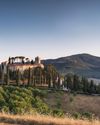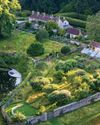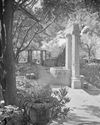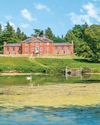
ON the wild, winding road to Flimston Chapel, a remote spot on the Pembrokeshire coast, you suddenly come across a sign in German: ‘FÜR LKW VERBOTEN’ (‘Forbidden for trucks’; LKW is short for Lastkraftwagen —German for trucks). Above it, in English, the sign says: ‘NO ACCESS FOR TANKS.’ The sign is one of the last relics of an extraordinary story. From 1961 to 1996, the German Army came to the Pembrokeshire Coast National Park to practise gunnery exercises and tank-firing out to sea at the Castlemartin Training Area.
My family’s seaside cottage is just by the military range, so my childhood holidays were punctuated by the sound of gunfire and by thrilling cliff walks past battered British Chieftain tanks and German Leopard tanks, used for target practice. One tank’s camouflaged turret had been flipped open and furled back like a tin of sardines, the only flash of colour a small, pristine Union Flag. On one thrilling bike ride, I found five spent bullets by the coast path and my mother once descended to Flimston Bay for a swim, only to be faced by 100 naked German soldiers about to go skinny-dipping.
Esta historia es de la edición February 17, 2021 de Country Life UK.
Comience su prueba gratuita de Magzter GOLD de 7 días para acceder a miles de historias premium seleccionadas y a más de 9,000 revistas y periódicos.
Ya eres suscriptor ? Conectar
Esta historia es de la edición February 17, 2021 de Country Life UK.
Comience su prueba gratuita de Magzter GOLD de 7 días para acceder a miles de historias premium seleccionadas y a más de 9,000 revistas y periódicos.
Ya eres suscriptor? Conectar

Give it some stick
Galloping through the imagination, competitive hobby-horsing is a gymnastic sport on the rise in Britain, discovers Sybilla Hart

Paper escapes
Steven King selects his best travel books of 2024

For love, not money
This year may have marked the end of brag-art’, bought merely to show off one’s wealth. It’s time for a return to looking for connoisseurship, beauty and taste

Mary I: more bruised than bloody
Cast as a sanguinary tyrant, our first Queen Regnant may not deserve her brutal reputation, believes Geoffrey Munn

A love supreme
Art brought together 19th-century Norwich couple Joseph and Emily Stannard, who shared a passion for painting, but their destiny would be dramatically different

Private views
One of the best ways-often the only way-to visit the finest privately owned gardens in the country is by joining an exclusive tour. Non Morris does exactly that

Shhhhhh...
THERE is great delight to be had poring over the front pages of COUNTRY LIFE each week, dreaming of what life would be like in a Scottish castle (so reasonably priced, but do bear in mind the midges) or a townhouse in London’s Eaton Square (worth a king’s ransom, but, oh dear, the traffic) or perhaps that cottage in the Cotswolds (if you don’t mind standing next to Hollywood A-listers in the queue at Daylesford). The estate agent’s particulars will give you details of acreage, proximity to schools and railway stations, but never—no, never—an indication of noise levels.

Mission impossible
Rubble and ruin were all that remained of the early-19th-century Villa Frere and its gardens, planted by the English diplomat John Hookham Frere, until a group of dedicated volunteers came to its rescue. Josephine Tyndale-Biscoe tells the story

When a perfect storm hits
Weather, wars, elections and financial uncertainty all conspired against high-end house sales this year, but there were still some spectacular deals

Give the dog a bone
Man's best friend still needs to eat like its Lupus forebears, believes Jonathan Self, when it's not guarding food, greeting us or destroying our upholstery, of course